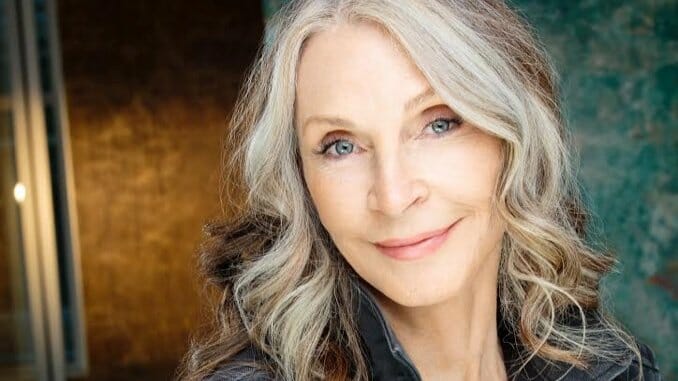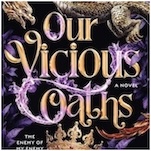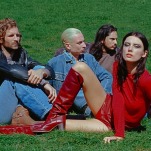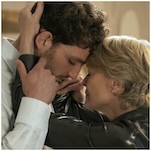Gates McFadden Boldly Goes Into the Podcast Booth
Photos courtesy of the artist
Before she was Dr. Beverly Crusher on Star Trek: The Next Generation, Gates McFadden worked with Muppets. She trained as a movement instructor under French pioneer Jacques Lecoq, choreographed Shakespeare at the Brooklyn Academy, and taught acting techniques at Harvard, Brandeis and several other top universities. She would have no doubt led a full and exciting life without boldly going where no man—or woman—had gone before. But there’s also no denying that accepting the role of the Enterprise’s chief medical officer completely changed the trajectory of that life. Six seasons. Four movies. Countless conventions. And now a podcast, in which she interviews all the dear friends she made along the way, InvestiGates: Who Do You Think You Are?.
And it almost didn’t happen. She initially turned the role down. Her agent was a big fan of the original Star Trek series, but she hadn’t seen an episode. Television still had a stigma for stage and film actors. Still she went into Paramount to audition, where a secretary handed her three parts.
“She said, ‘These are the women parts,’” McFadden tells me over Zoom in front of a wall of books and theater mementos. “And I said, ‘Well, which one?’ She said, ‘Well, I don’t know, pick whatever one you want.’ No one else was there. … So I went in and I picked the funniest scene because I love comedy. And that was Dr. Crusher’s only comedy scene in about seven years. I had like two or three comic scenes in the entire time—she was such a serious character. And I thought she was going to be the comic character. Right. So I picked that scene. It’s a silly episode, but it was a very fun part to do where [Captain Jean-Picard] and I both have this virus that kind of makes you free and we’re coming on to each other, you know? And I unzipped my space suit. I got into so much trouble for that when we finally shot it. But that’s how it happened. So it was just this fluke, you know?”
McFadden grew up in the small town of Cuyahoga Falls in northeastern Ohio, studying dance from teachers “who wished they were in New York.” But it was in college, at Brandeis University, where she learned she could follow her passion. When professors threatened to fail her and other students and keep her from graduating if she protested the Vietnam War, she went out on strike anyway. When Lecoq made his first U.S. visit to Harvard, she took his class, studying acting movement—using masks, mime and physical performance—eventually becoming his assistant.
“That changed my life,” she says. “I went, ‘Okay, I want to change the world, create new things.’ He had a very particular way of teaching, and I loved it. And now every theater school has somebody teaching his techniques, but nobody did at that time. It was a huge growth period for me. It was so diverse. You had people from all over the world. We could barely all communicate, and we’d have to come up with a new creation every week. It wasn’t, at that point about, ‘Gee, I’m going to be an actor, and this is my career.’ It was really, truly about coming up with new forms and ways of expressing your thoughts about what you see in the world and how you experience it.”
She started taking jobs that Lecoq couldn’t do because he wanted to return to France. Some of those jobs involved teaching at Harvard and Brandeis, where her students included David Crane and Marta Kauffman, who went on to create Friends. Another of those jobs was for Jim Henson. “We studied masks in different cultures. So when you study a mask, you have to learn about articulation. And that of course is exactly what puppets have to do.”
She soon found herself auditioning for Muppets Take Manhattan. “This was like one of the very first things I’d ever gone up for,” she says. “And usually you walk in a room and there’s like five million people who look just like you as your competitor. And they’re all going in the room reading for the same part, that’s going to be like, you know, two pages long. And there was nobody there. And I’m at Jim Henson’s office, and someone says, ‘He’ll see you now.’ And I walk in and it’s just me. And I was all ready to read the script, and he doesn’t make me read the script. I didn’t know he’d seen me act, and he didn’t say anything. And so I go out and I’m like, ‘Well, that’s a really cool way to audition. Yes, this is going to be a good profession.’ Never again. And I got cast, it was so much fun. I got to work with Kermit, who I just adored, and I met Frank Oz and a lot of other people and meanwhile, [Henson] was grooming me, but I didn’t know that.”
Soon she found herself working as a choreographer on Labyrinth, directing the movements of David Bowie along with an army of goblins. “It was an enormous job and I did not have the time to fan girl. Seriously, in retrospect, what a fool—I should have hung out and just have that extra cup of tea and just talked about Wimbledon more. But I was always like, ‘Okay, I’ll see you. I’ve got to run.’ I should have stayed because he is one of my favorite artists.”
Oz then tried to hire her to choreograph Audrey II in the film adaptation of Little Shop of Horrors, but she didn’t want to only do choreography—she wanted to go back to acting. She did a screen test with Robert DeNiro for Big before he dropped out and the role went to Tom Hanks, and that’s when Star Trek came along. She turned that down at first, too, to go do a play “for like next to no money.”
“I think I was so naive or ignorant—that’s the better word,” she says. “I think I was very ignorant about the biz and how you did things. I am so lucky that they came back and asked me to do it [again].”
Being part of Gene Roddenberry’s beloved franchise has meant more than steady residuals from syndication and a forever job wherever the show’s fans might gather. It’s meant being a role model to women who saw her on the screen and believed that they could become a doctor or a scientist. Or foster children now in their thirties telling her that she was their mother figure growing up. It also provided her with a group of lifelong friends from both the Next Generation cast and the spin-offs that followed.
-

-

-

-

-

-

-

-

-

-

-

-

-

-

-

-

-

-

-

-

-

-

-

-

-

-

-

-

-

-

-

-

-

-

-

-

-

-

-

-









































